engine AUDI A8 2014 Owners Manual
[x] Cancel search | Manufacturer: AUDI, Model Year: 2014, Model line: A8, Model: AUDI A8 2014Pages: 314, PDF Size: 78.47 MB
Page 274 of 314
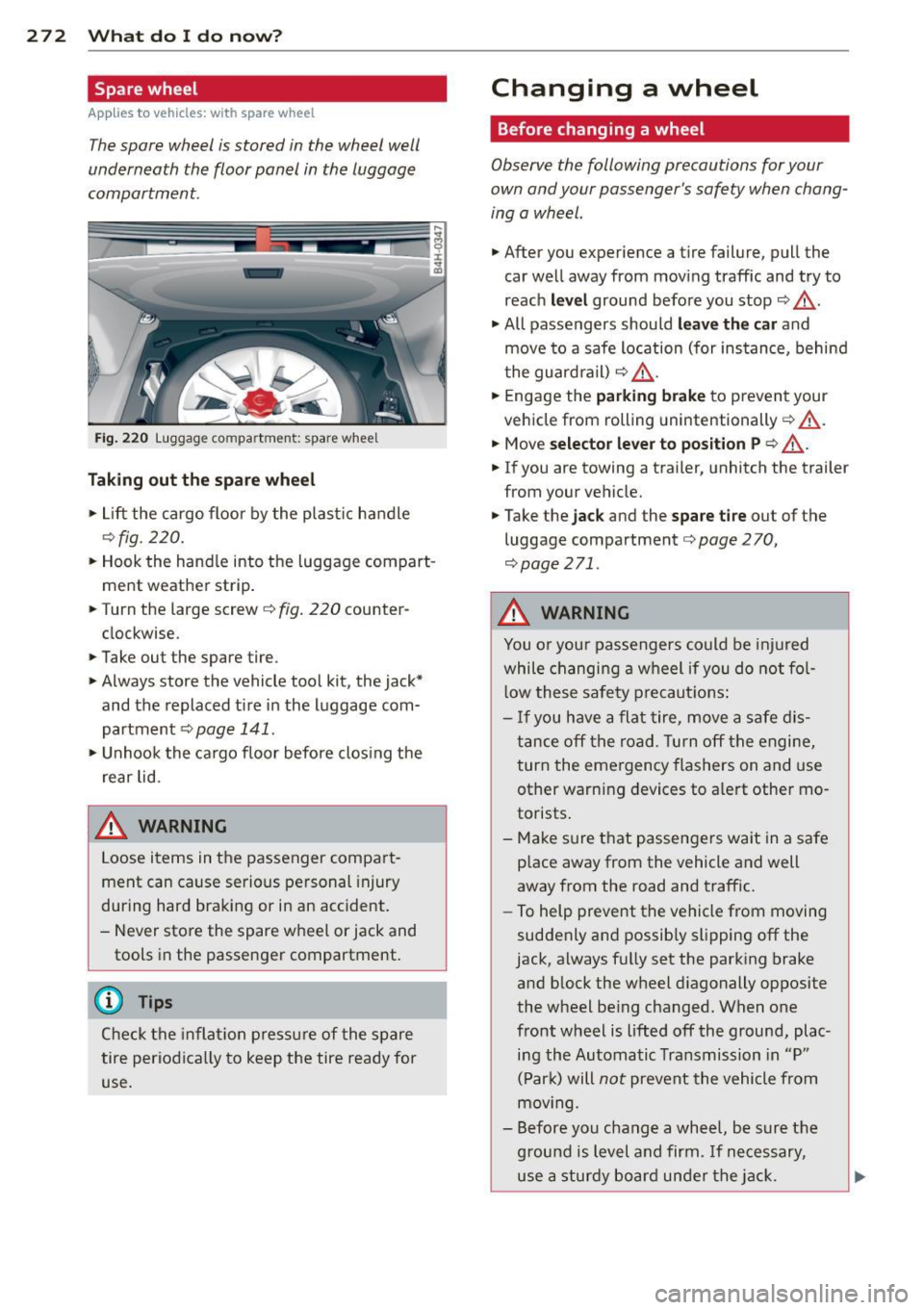
272 What do I do now ?
Spare wheel
App lies to vehicles: with spare wheel
The spare wheel is stored in the wheel well
underneath the floor panel in the luggage
compartment.
Fig. 220 L uggage compartment: spare wheel
Taking out the spare wheel
.,. Lift the cargo floor by the plastic handle
¢fig. 220.
.. Hook the hand le into the luggage compart
ment weather strip .
.. Turn the large screw¢
fig. 220 counter
clockwise.
.. Take out the spare tire.
.. Always store the vehicle tool kit, the jack*
and the replaced tire in the luggage com
partment ¢
page 141.
.,. Unhook the cargo floor before closing the
rear lid.
&_ WARNING
-
Loose items in the passenger compart
ment can cause serious personal injury
during hard braking or in an accident.
- Never store the spare wheel or jack and
tools in the passenger compartment.
(D Tips
Check the inflat ion pressure of the spare
tire periodically to keep the tire ready for
use.
Changing a wheel
Before changing a wheel
Observe the following precautions for your
own and your passenger's safety when chang
ing a wheel.
.. After you experience a tire failure, pull the
car well away from moving traffic and try to
reach
level ground before you stop ¢ .&_ .
.. All passengers should leave the car and
move to a safe location (for instance, behind
the guardra il)¢ .&_ .
.. Engage the
parking brake to prevent your
vehicle from rolling unintentionally¢ .&_.
.. Move
selector lever to position P ¢ A .
.. If you are towing a trailer, unhitch the trailer
from your vehicle .
.,. Take the
jack and the spare tire out of the
luggage compartment¢
page 270,
¢page 271.
&_ WARNING
You or you r passengers could be injured
while changing a wheel if you do not fol
l ow these safety precautions:
-If you have a flat tire, move a safe dis
tance off the road. Turn off the engine,
turn the emergency flashers on and use
other warning devices to alert other mo
torists .
- Make sure that passengers wait in a safe
p lace away from the vehicle and well
away from the road and traffic.
- To help prevent the vehicle from moving
suddenly and possib ly slipping off the
jack, always fully set the parking brake
and block the wheel d iagonally opposite
the wheel be ing changed. When one
front wheel is lifted off the ground, plac ing the Automatic Transmission in "P"
(Par k) will
not prevent the vehicle from
mov ing.
- Before you change a wheel, be sure the
g rou nd is level and firm. If necessary,
use a sturdy board under the jack.
-
Page 281 of 314
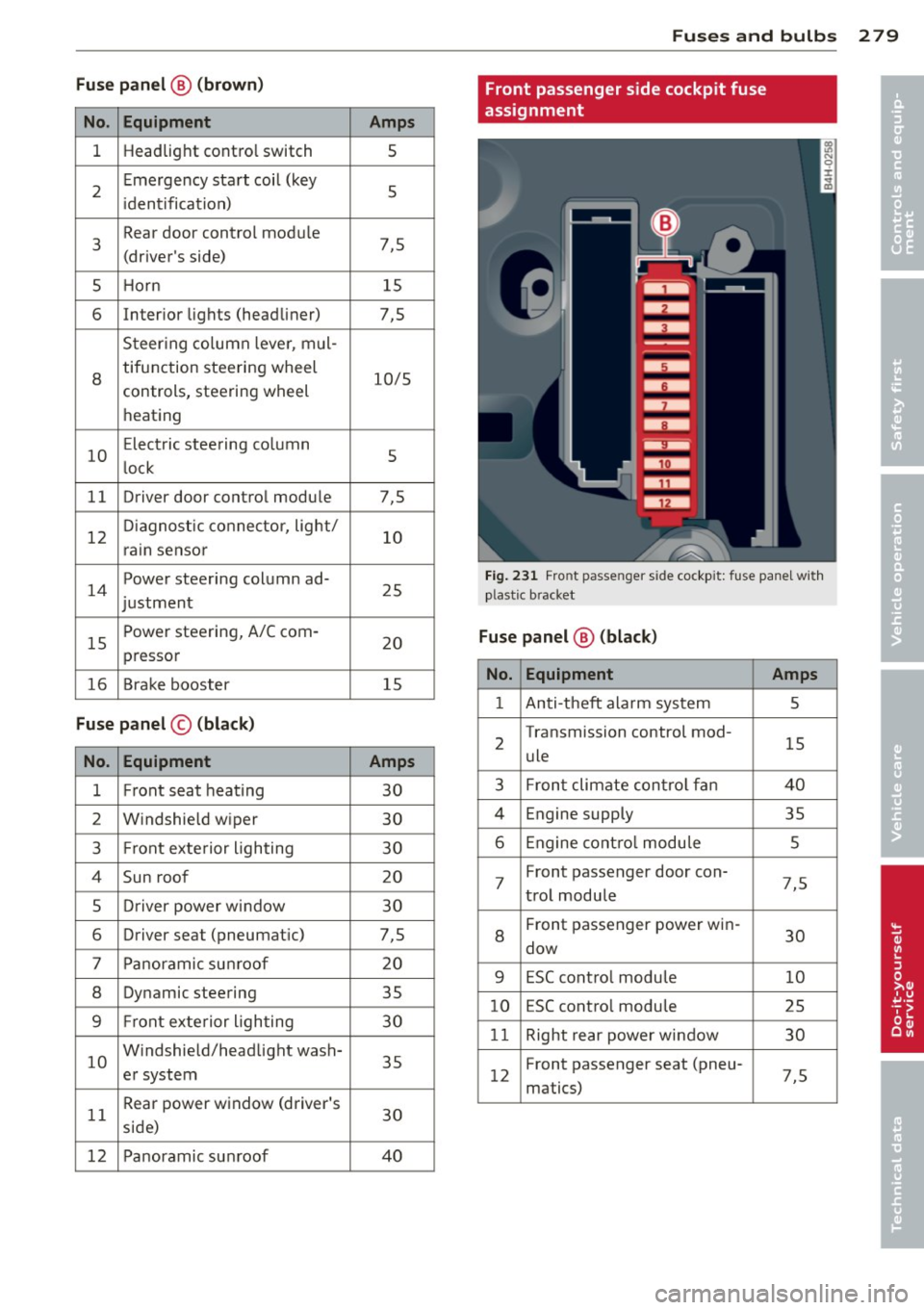
Fuse pa nel @ (brown )
No . Equipment
1 Headlight contro
l switch
2 Emergency
start coil (key
i dentification)
3 Rear door
control module
(driver's side)
5 Horn
6 Interior
lights (headliner)
Steer ing column leve r, mul-
8
tifunction steering wheel
controls, steering wheel
heating
10 E
lectric steering column
l ock
11 Driver door
control module
12 D
iagnostic connector, light/
rain sensor
14 Powe
r steering column ad-
justment
15 Power steering, A/C com-
presser
16 Brake booster
Fu se p anel © (black )
No. Equipment
1 Front seat heating
2 Windshield
wiper
3 Front exte rior lighting
4 Sun roof
5 D river power window
6 Driver
seat (pneumatic)
7 Pano ramic sunroof
8 Dynamic
steering
9 Front exterior lighting
10 W
indshield/headlight wash-
er system
11 Rear power
window (driver's
side)
12 Panoramic sunroof
Amp s
5
5
7,5 15
7,5
10/5
5
7,5
10
25
20 15
Amp s
30
30 30
20
30
7,5 20
35
30
35
30
40
Fu ses and bulb s 2 79
Front passenger side cockpit fuse
assignment
Fig . 231 Front passenger side cockpit: f use pane l with
plast ic bracket
Fu se panel @ (bl ac k)
No. Equipment Amps
1 Anti-theft alarm system 5
2 Transmission control
mod-
15
ule
3 Front climate control fan
40
4 Engine supply 35
6 Engine cont ro l modu le 5
7 Front
passenger door con-
7,5
trol module
8
Front passenger power win-
30
dow
9 E5C contro l module 10
10 ESC
contro l modu le
25
1 1 Right rear power window 30
1 2 Front
passenger seat (pneu-
7,5
matics)
•
•
Page 282 of 314

280 Fuses and bulbs
Luggage compartment fuse assignment
Fig. 23 2 Luggage compartment: fuse pa nel with plas tic bracket
Fuse panel @ (black )
No. Equipment Amps
No. Equipment Amps
11 Dynam ic steer ing 5
E SC button, da ta logger, di· 12
Selector lever,
BCM-2
5
1 agnostic connector, BCM · 1,
5 13 Audi s ide ass ist 5
adap tive light ing system
14 Engine control modu le
5
2 Networking gateway
5
15 Sta rter 40
3 adap tive air s usp ension 5
4 Parking system
5 16 Left headlight/Headlight
10/5
range control system
5 Steering colum n leve r 5
6
Suspension contro l system
5
sensor
Fu se panel @ (red)
No. Equipment Amps
7 Bel
t tensione rs, airbag con-
5
trol module
Heated washe r fl uid no zzles, 1
Left reversible be
lt tens ioner
2S
2 Right revers
ible belt ten -
25
sioner
H ome link (garage door
Starter diagnos is, DC/DC
8 opener), nig ht vision system 5
3 co
nverter (S tart-Stop-Sys·
5
con trol mod ule, sport diffe r-
tern)
ent ia l, ionizer
9
Electromechan ica l park ing
5
brake contro l modu le 4
DC/DC converter (Start-
7,5
Stop-System)
5 Image proce ssing 7,5
10 Rear seat heating, coo
ler, in·
5
terior rearview mirror
Page 284 of 314
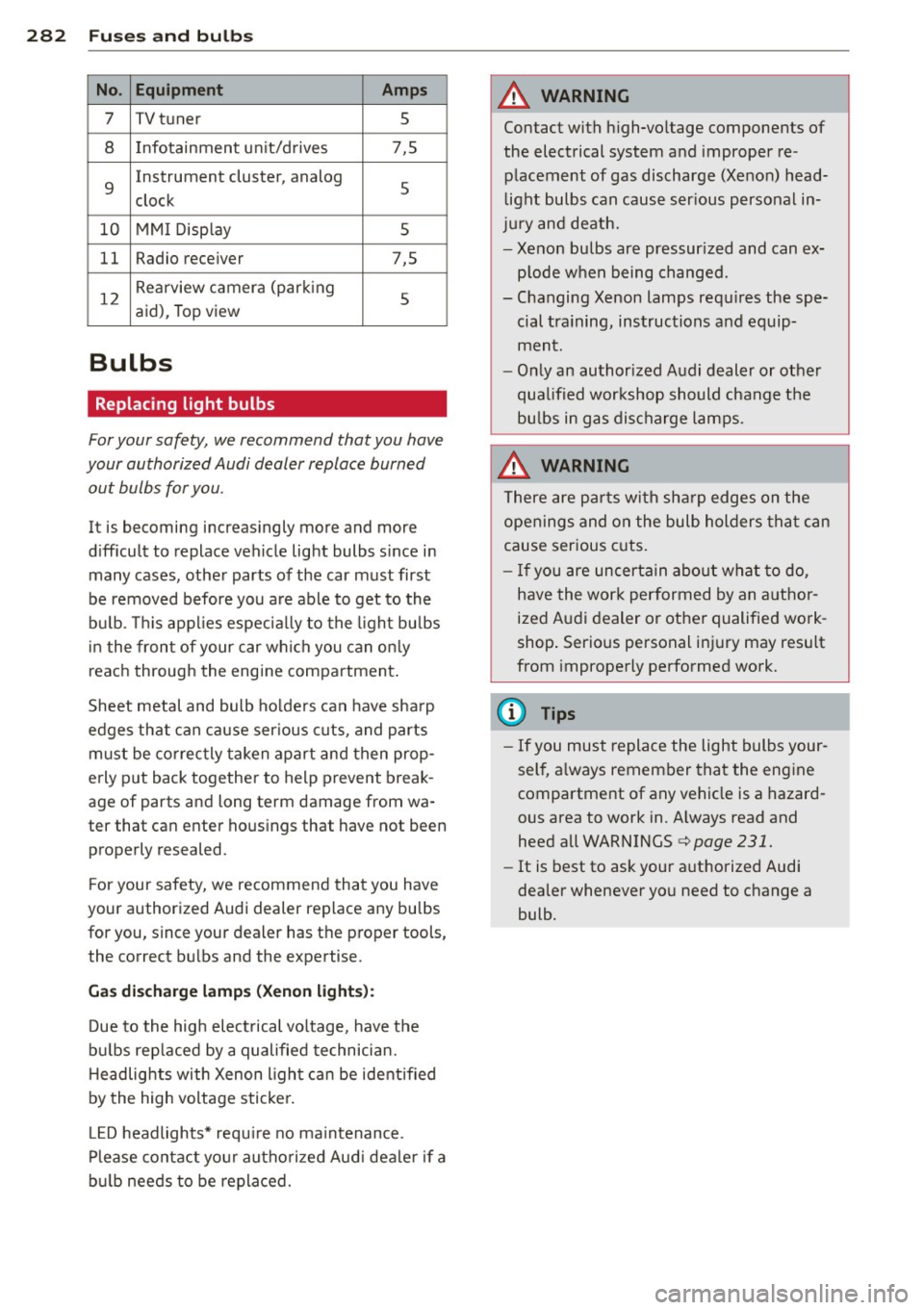
282 Fuses and bulb s
No. Equipment Amps
7 TV tuner 5
8 Infotainment un it/drives 7,5
9
I nstrument cluster, analog
5
clock
10 MMI Display 5
11 Radio receiver 7,5
1 2
Rearview camera (park ing
5 aid), Top view
Bulbs
Replacing light bulbs
For your safety, we recommend that you have
your authorized Audi dealer replace burned out bulbs for you .
It is becoming increasingly more and more
difficult to replace vehicle light bulbs s ince in
many cases, other parts of the car must first
be removed before you are able to get to the
bu lb . Thi s applies especially to the light bu lbs
in the front of your car which you can only
reach through the engine compartment .
Sheet metal and bulb holders can have sharp
edges that can cause ser ious cuts, and parts
must be correctly taken apart and then prop
erly put back together to help prevent break
age of parts and long term damage from wa
ter that can enter housings that have not been
properly resealed.
F or your safety, we recommend that you have
your authorized Audi dealer replace any bulbs
for you, since your dealer has the proper tools,
the correct bu lbs and the expertise.
Gas discharge lamps (Xenon lights):
Due to the high electrical vo ltage, have the
bu lbs rep laced by a qualified technician.
Headlights with Xenon light can be ident ified
by the high voltage sticke r.
LE D headlights* require no ma intenance .
Please contact your authorized Aud i dealer if a
bu lb needs to be replaced.
A WARNING
Contact with high-voltage components of
the electrical system and improper re
placement of gas discharge (Xenon) head
light bulbs can cause ser ious personal in
jury and death.
- Xenon bulbs are pressur ized and can ex
p lode when being changed.
- Changing Xenon lamps requ ires the spe
cial tra ining, instructions and equip
ment.
- Only an authorized Audi dealer or other
qualified workshop should change the
bu lbs in gas discharge lamps .
A WARNING
There are parts with sharp edges on the
openings and on the bulb holders that can
cause serious cuts.
- If you are uncertain about what to do,
have the work performed by an author
ized Audi dealer or other qualified work
shop. Serious personal injury may result
from improperly performed work.
(D Tips
-If you must replace the light bulbs your
self, a lways remember that the engine
compartment of any vehicle is a hazard
ous area to work in. Always read and
heed all WARNINGS
c> page 231.
-It is best to ask your authorized Audi
dealer whenever you need to change a
bulb.
-
Page 285 of 314
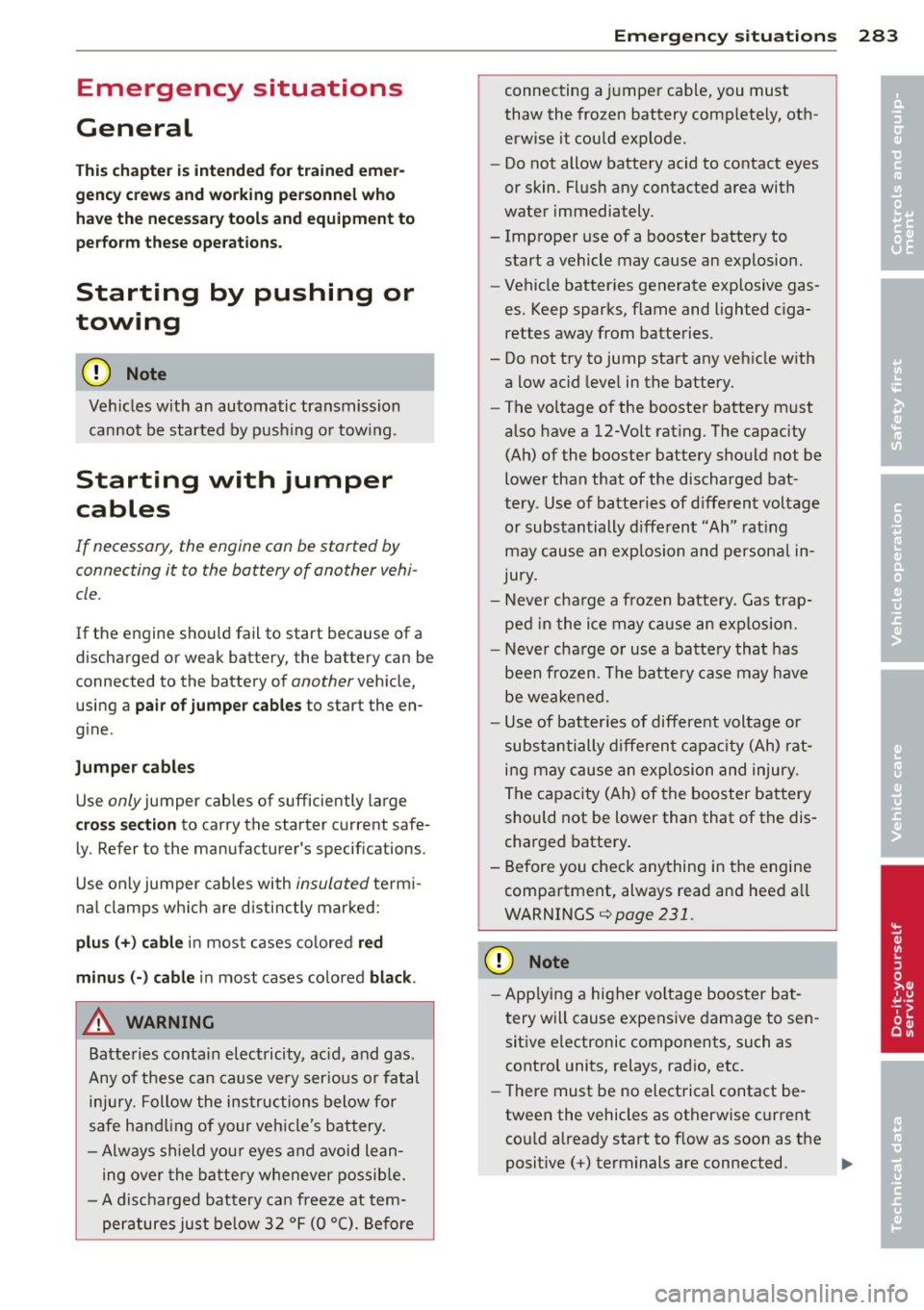
Emergency situations
General
This chapter i s intended for trained emer
gency crews and working personnel who have the necessary tools and equipment to
perform these operations.
Starting by pushing or
towing
(D Note
Ve hicles w ith an au tomatic tra nsmission
cannot be started by pus hing o r tow ing.
Starting with jumper
cables
If necessary, the engine can be started by
connecting it to the battery of another vehi
cle.
If the engine shou ld fail to start because of a
discha rged o r wea k battery, the battery can be
connected to the battery o f
another vehicle,
using a
pair of jumper cables to start the en
g ine.
Jumper cables
Use only jumper cables of sufficiently la rge
c ross section to carry the starter c urrent safe
l y. Refer to the man ufacturer's specifications.
Use only jumper cables with
insulated te rm i
na l clamps wh ic h are d istinctly marked:
plus(+) cable i n mos t cases co lore d red
minu s(-) cable
in most cases colored black .
A WARNING
Batterie s contain e lec tricity, ac id, an d gas.
A ny of these can cause ve ry ser io us or fatal
inju ry. Follow the instructions below f or
safe han dling of your veh icle's b attery .
- Alway s shield you r eyes and avoid lean
ing over the bat te ry whenever possib le.
- A dis ch arged battery c an free ze at tem
peratures ju st be low 32 °F ( 0 °C ). Befo re
Emergency situations 283
connecting a jumpe r cab le, you must
thaw the frozen battery c omp lete ly, ot h
erwise it could explode.
- Do not allow battery acid to contact eyes
or skin. Fl ush any contacted area with
wate r immediately.
- Improper use of a booster battery to start a vehicle may cause an explosion.
- Vehicle batter ies genera te exp losive gas
es. Keep spar ks, flame and lighted c iga
rettes away from batte ries.
- Do not try to jump start any ve hicle w ith
a low ac id leve l in the battery.
- The vo ltage of the booste r batte ry m ust
a lso have a 12-Vol t rating. T he capacity
(Ah) of the booster battery sho uld not be
lowe r tha n that of the discharged bat
tery . Use of batte rie s of d iffe ren t voltage
or substantially diffe rent "Ah" rat ing
may c au se an exp losion and persona l in
JU ry.
- N ever cha rge a fro zen battery. Gas trap
pe d in the ice may cause a n ex plosion.
- Never cha rge or use a batte ry tha t h as
been fr ozen. T he battery case may have
be weakened.
- Us e of b atter ies of differe nt voltage or
sub stant ia lly diffe ren t ca pa city (Ah) ra t
i ng may c ause an ex plosion an d injury .
Th e capac ity (Ah) of the booster bat tery
should not be lower than that of the dis
charged batte ry .
- Before you chec k any thing in the engine
compa rtment, always read and hee d all
WARNINGS
¢page 231.
(D Note
-App lyin g a higher vo ltage booster ba t
t ery w ill cause expens ive damage to se n
sit ive e lectronic com ponents, such as
cont ro l units, relays, rad io, etc.
- The re must be no electrical contact be
tween the vehicles as ot herwise c urrent
co uld a lready start to f low as soon as the
p o sit ive(+) term inals a re connected. ..,. •
•
Page 286 of 314
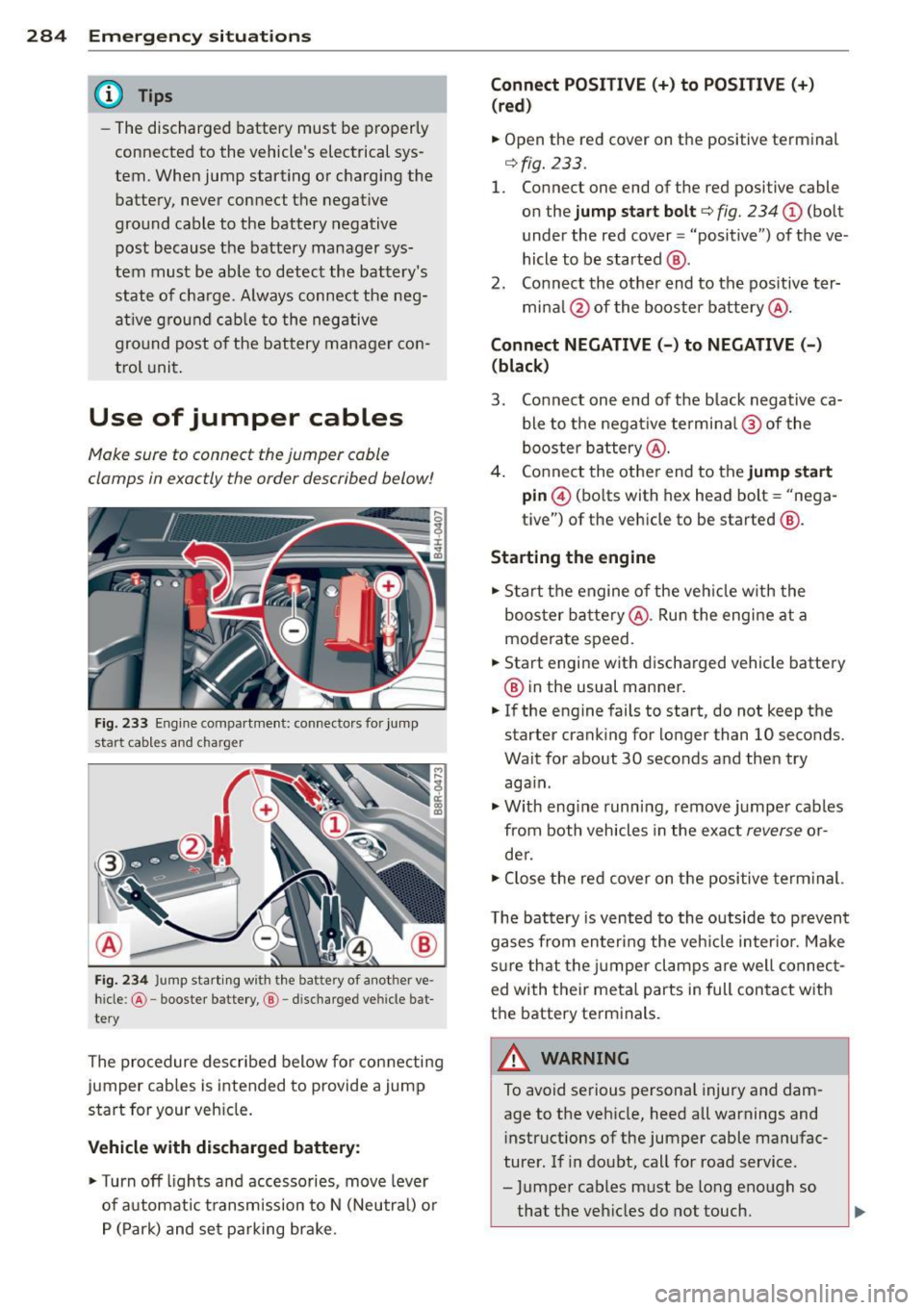
284 Emergency situations
@ Tips
-The discharged battery must be properly
connected to the vehicle's electrical sys
tem. When jump starting or charging the
battery, never connect the negative
ground cable to the battery negative
post because the battery manager sys
tem must be able to detect the battery's
state of charge . Always connect the neg
ative ground cable to the negative
ground post of the battery manager con
trol unit.
Use of jumper cables
Make sure to connect the jumper coble
clomps in exactly the order described below!
Fig . 233 Engine co mpartment: connecto rs fo r jump
star t cab les and c harg er
Fig. 234 Ju m p sta rt in g w it h the ba ttery of anot her ve
h icle :@ - booster battery, @-discharge d ve hicle bat
tery
The procedure described below for connecting
jumper cables is intended to provide a jump
start for your vehicle.
Vehicle with discharged battery:
•Turnoff lights and accessories, move lever
of automatic transmission to N (Neutral) or
P (Park) and set parking brake.
Connect POSITIVE(+) to POSITIVE(+)
(red)
• Open the red cover on the pos itive terminal
¢ fig. 233 .
1. Connect one end of the red positive cable
on the
jump start bolt c::;, fig. 234 @ (bolt
under the red cover = "positive ") of the ve
hicle to be started @.
2. Connect the other end to the positive ter-
mina l@ of the booster battery@.
Connect NEGATIVE (-) to NEGATIVE (-)
(black)
3. Connect one end of the black negative ca
ble to the negat ive terminal @ of the
booster battery @.
4. Connect the other end to the
jump start
pin © (bolts with hex head bolt= "nega
tive") of the vehicle to be started @.
Starting the engine
• Start the engine of the veh icle w ith the
booster battery@. Run the engine at a
moderate speed.
• Start engine with discharged vehicle battery
@ in the usual manner.
• If the engine fails to start, do not keep the
starter cranking for longer than 10 seconds.
Wait for about 30 second s and then try
aga in.
• With engine running, remove jumper cables
from both vehicles in the exact
reverse o r
de r.
• Close the red cover on the positive term inal.
T he battery is vented to the outside to prevent
gases from entering the veh icle inter ior. Make
sure that the jumper clamps are well connect
ed with their metal parts in full contact with
the battery terminals.
_& WARNING
To avoid serious personal injury and dam
age to the vehicle, heed all warnings and
instructions of the jumper cable manufac
turer. If in doubt, call for road service.
- Jumper cables must be long enough so
that the veh icles do not touch.
-
Page 287 of 314
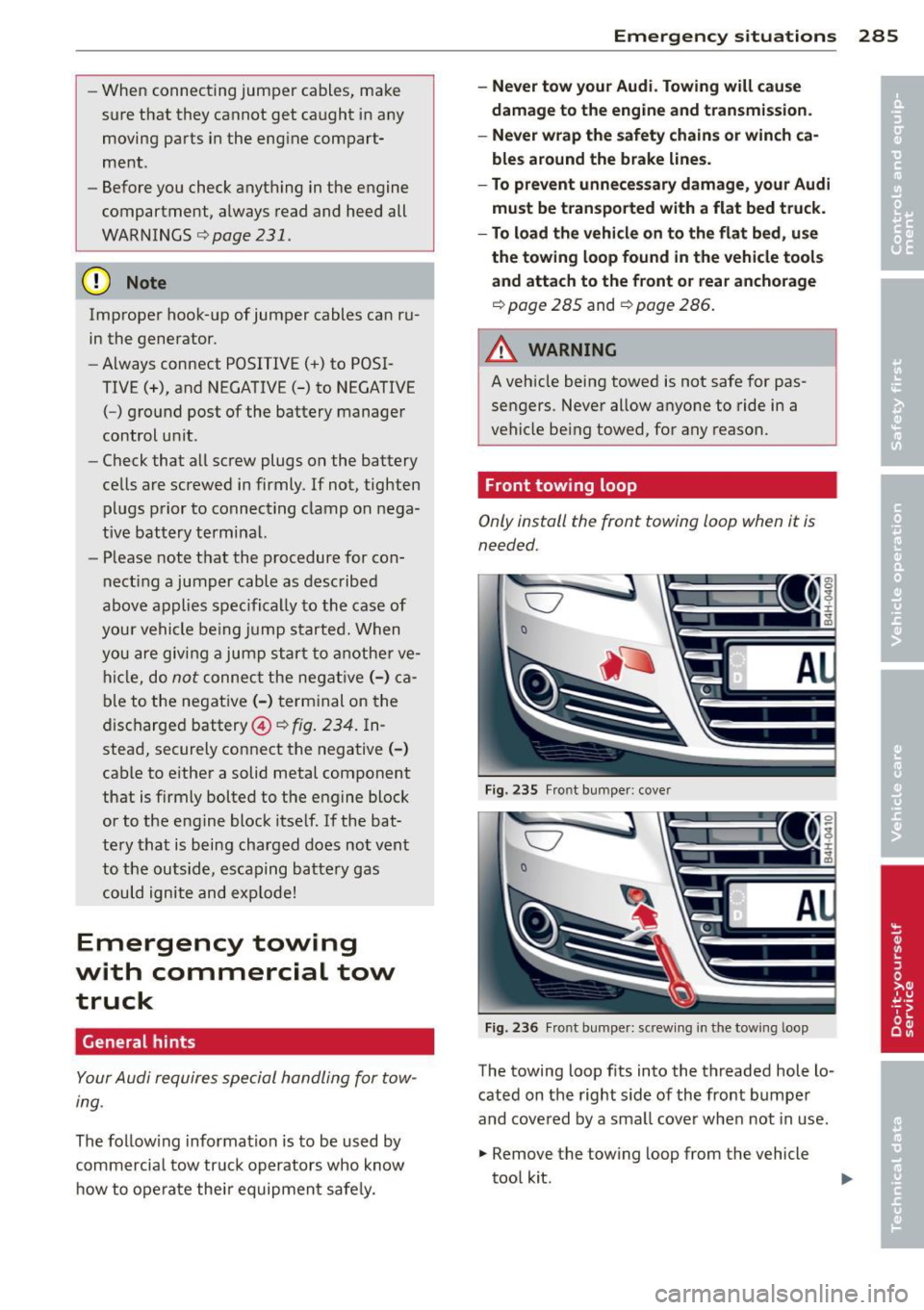
-When connecting jumper cables, make
sure that they cannot get caught in any
moving parts in the eng ine compart
ment .
- Before you check anything in the engine
compartment, always read and heed all
WARNINGS
¢ page 231.
(D Note
Improper hook-up of jumper cables can r u
in the generator.
- Always connect POSITIVE( +) to POSI
TIVE(+), and NEGATIVE(-) to NEGATIVE
( - ) gro und post of the battery manager
control unit .
- Check that all screw plugs on the battery
cells a re screwed in firmly . If not, tighten
pl ugs p rior to connecting clamp on nega
tive battery term inal.
- Please note that the procedure f or con
nect ing a jump er cable as desc ribed
above appl ies spec ifically to the case of
you r vehi cle be ing jump started. When
you are giv ing a jump star t to an othe r ve
hi cle, do
not connec t the negat ive (-) ca
ble to the negat ive (-) terminal on the
discharged battery @¢
fig. 234. In
stead, securely connect the negative( -)
cable to e ithe r a solid metal component
that is firmly bolted to the engine block
or to the e ng ine block itse lf. If the bat
te ry tha t is being charged does not vent
to the outside, escaping batte ry gas
could igni te and exp lode!
Emergency towing
with commercial tow truck
General hints
Your Audi requires special handling for tow
tng.
The follow ing information is to be used by
commercia l tow tr uck operators who know
h ow to ope rate thei r equipme nt safe ly.
Emergenc y situ ation s 285
-Ne ver tow your Audi. Towing will cause
damage to the engine and tran smission.
- Never wrap the safety chain s or w inch ca
ble s around the brake lines.
- To prevent unnece ssary damage , your Audi
must be transported with a flat bed tru ck.
- To load the vehicle on to the fl at bed , use
the towing loop found in the vehicle tools
a nd attach to the front or rear anchora ge
¢ page 285 and ¢ page 286 .
_& WARNING
A vehicle being towed is not safe for pas
sengers. Never allow anyo ne to ride in a
vehicle be ing towed, for any reason.
Front towing loop
Only install the front towing loop when it is
needed.
Fig. 23 5 Front bu mpe r: cove r
Fig. 236 Fr ont bu mpe r: sc rew ing in t he tow ing loop
-
The towing loop f its into the threaded hole lo
cated on the right s ide of the front bumpe r
and cove red by a sma ll cove r when not in use .
.. Remove the tow ing loop from the vehicle
too l kit .
Page 290 of 314
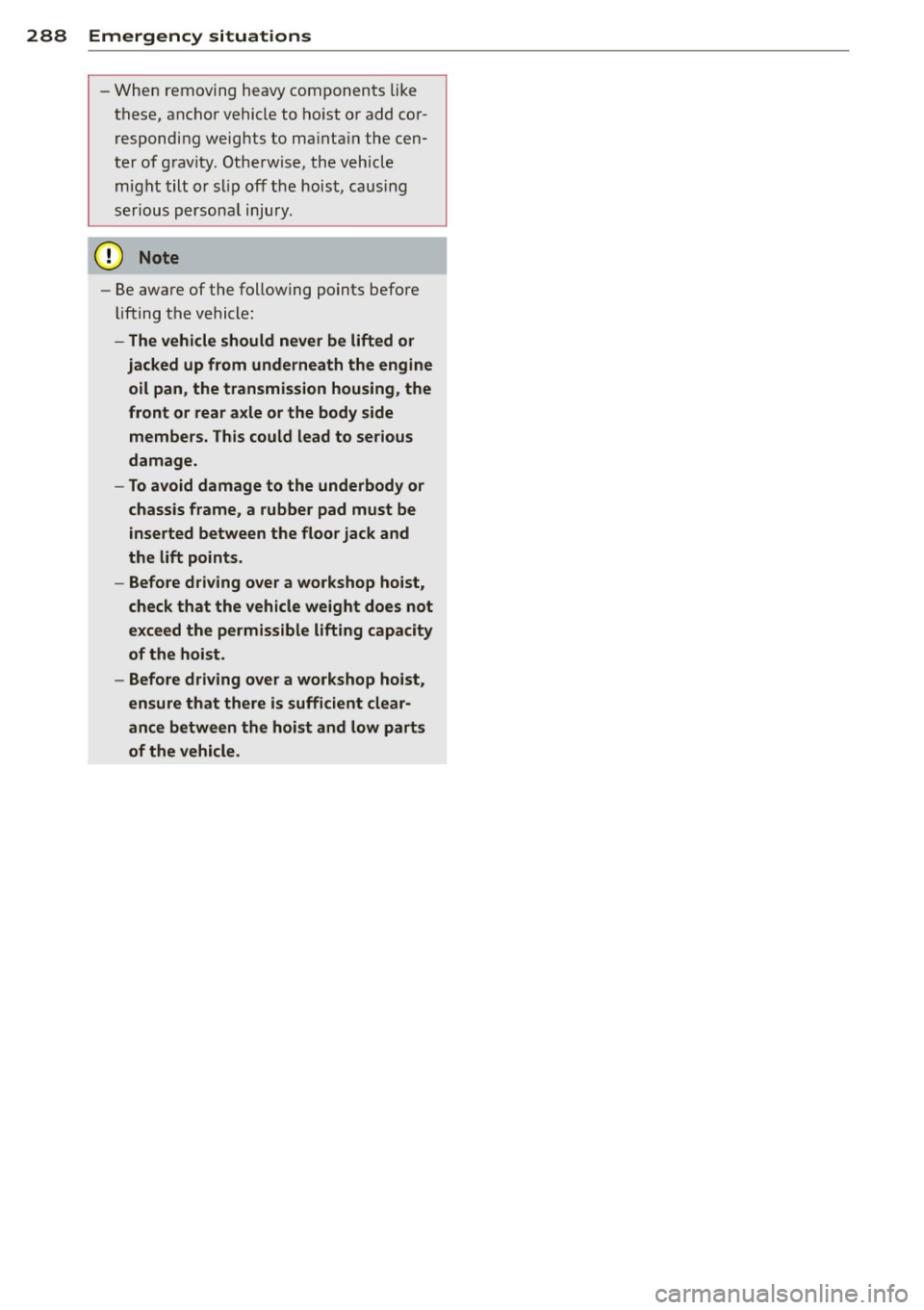
288 Emergency situations
- When removing heavy components like
these, ancho r vehicle to ho ist o r add cor
responding weig hts to ma inta in the cen
ter of g ravity. Othe rwise, the vehicle
m ight tilt o r slip off t he hoist, causi ng
serious p erson al inju ry .
@ Note
- Be awa re of the following points befo re
li fting the vehicle:
- The vehicle should never be lifted or
jacked up from underneath the engine
oil pan, the transmission housing , the
front or rear axle or the body side membe rs. This could lead to serious
damage.
- To avoid damage to the underbody or
chassis frame, a rubber pad must be
inserted between the floor jack and
the lift points.
- Before driving over a workshop hoist,
check that the veh icle weight does not
exceed the permissible lifting capacity
of the hoist .
-Before driving over a workshop hoist,
ensure that there is sufficient clear
ance between the hoist and low parts
of the vehicle.
Page 291 of 314

Technical Data
Vehicle identification
F ig. 2 42 Veh ide Identificat ion Numbe r (VlN) plate: lo ·
c ation on dri ver 's s ide das h pane l
XXXXX XX · X -XXXX XXX
~ fAllftlli. -llllll · NR. ~ W!ru -IIOO -NO.
xx
XXXX XXXX XX X XXXXXXXX
XXX XXX
IYP /TYPE
XX XXXXXXX XX X X XX
XXX KW XXX
®i ~W.::·f :l~~ XXXX XXX XXX
©+ ::rw= xxxx I xxxx XXX I xx
M. · AUSSt I IJ'IIDIIS
~--
EOA 7D 5 4UB 6XM SSG SRW
2E H JDZ 1LB lA S 18A
3FC SMU 7X l
FD A 9G3 OG7 OYH OJF
TL6 3 KA 8EH UlA X98 027
lXW 803 908 824 D2D
7T6 CV7 7KO 4X3 2K2
3L4 4KC 3YO 413 502
1S A 7GB 01A 4GO
XX. X XX X XX X XXXX
Fig. 243
T h e vehicle identification label - inside the
luggage co mpartment
Veh icle Id entifica tion Numb er (VlN )
The Veh icle Iden tifica tion Number is located
in different p laces :
- under the w indshield on the driver's side
~fig. 242.
- in the MMI: Select: Function button ICAR ! >
Car syste m s> VIN numb er.
- on the vehicle identification label.
V ehicle ident ific ation lab el
The vehicle identification label is located in
the luggage compartment in the spare wheel
well.
Te chni cal Data 289
The label ~ fig. 243 shows the fo llowing vehi
cle data :
(D Vehicle Ident ifi cat ion Number (V IN)
@ Vehicle type, engine output, transmission
@ Engine and transm ission code
@ Paint number and interior
® Optional equipment numbers
The information of the vehicle identification
label can also be found in your Warranty
&
Maintenance booklet.
Saf ety compliance sticker
T he safety compliance sticker is your assur
ance that your new veh icle complies with all
applicable Federa l Motor Vehicle Safety
Standards which were in effect at the time the
vehicle was manufactured. You can find this
sticker on the door jamb on the driver's side.
It shows the month and year of production
and the vehicle ident ificat ion number of your
vehicle (perforat ion) as well as the Gross Veh i
cle Weight Rating (GVWR) and the Gross Ax le
Weight Rating (GAWR) .
High volt age warning lab el
The high voltage warning label is located in
the engine compartment next to the engine
hood re lease. The spark ign ition system com
plies with the Canadian standard IC ES-002.
Weights
Gross Vehicle Weight Rating
The Gross Vehicle Weight Rat ing (GVWR), and
the Gross Axle Weight Rating (GAWR) for
front and rear are listed on a sticker on the
doo r jamb on the driver's s ide.
The Gross Vehicle Weight Rat ing includes the
weight of the bas ic vehicle plus fu ll fuel tank,
o il and coo lant, plus maximum load , which in
cludes passe nger we igh t (1 50 lbs/68 kg pe r
designated sea ting position) and luggage
weight ~.& -
II>
Page 293 of 314
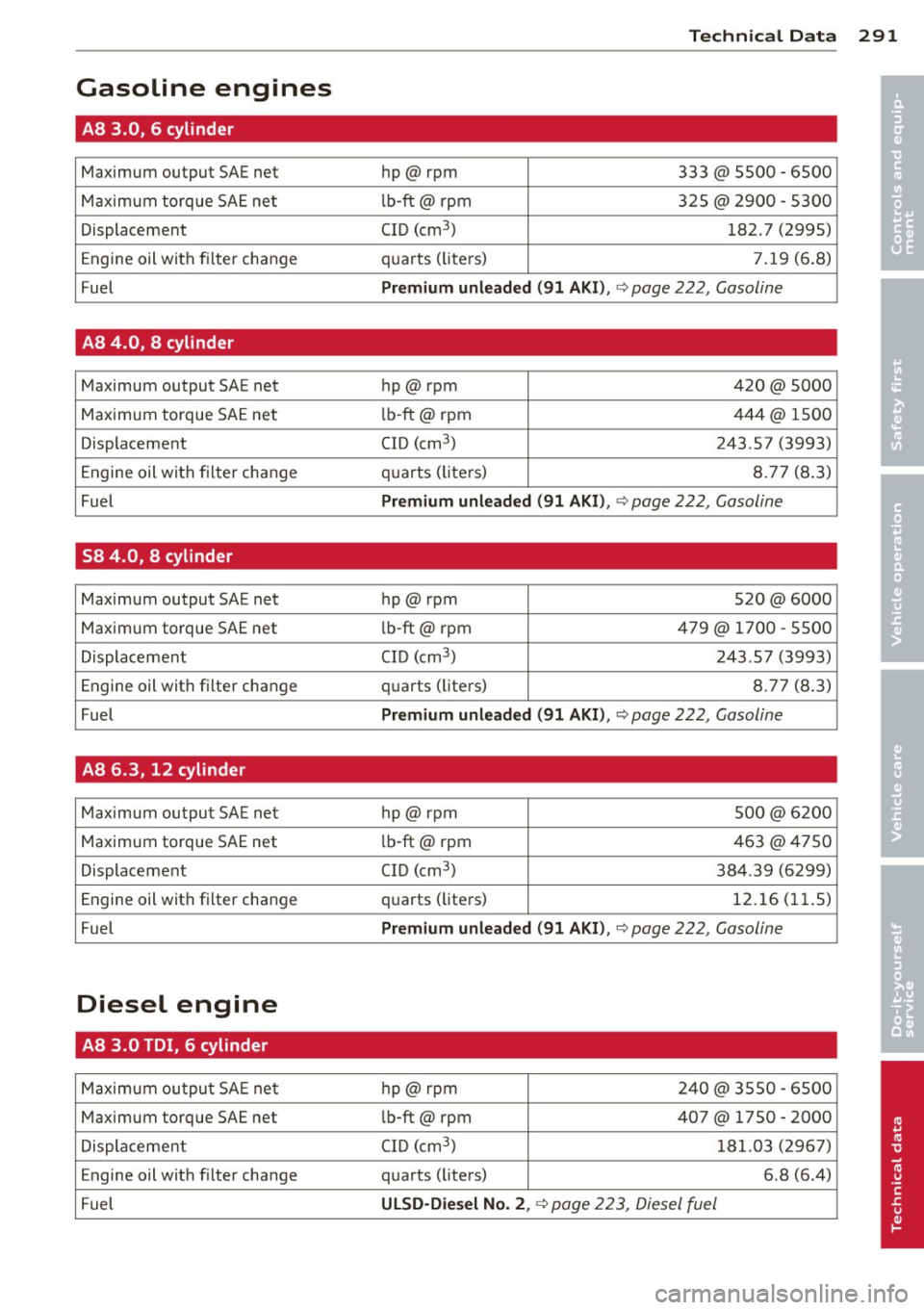
Technical Dat a 291
Gasoline engines
•
AB 3.0, 6 cylinder •
Maximum output SAE net hp@rpm 333 @ 5500 -6500
Maximum torque SAE net lb-ft@ rpm 325@ 2900 - 5300
Displacement CID (cm
3
) 182 .7 (2995)
Engine oil with f ilter change q
uarts (liters) 7.19 (6 .8)
Fuel
Prem ium unleaded (91 AKI) , ¢page 222, Gasoline
AB 4.0, 8 cylinder
Maximum output SAE net hp@rpm 420@5000
Maximum torque SAE net l
b -ft@ rpm
444@1500
Displacement CID (cm
3
) 243.57 (3993)
Engine oil with filter change q
uarts (liters) 8.77 (8.3)
Fuel
Premium unleaded (91 AKI) , ¢page 222, Gasoline
58 4.0, 8 cylinder
Maximum output SAE net hp@rpm 520@6000
Maximum torque SAE net l
b -ft@ rpm 479@ 1700 -5500
Displacement CID (cm3
) 243.57 (3993)
Engine oil with filter change q uarts (li ters) 8.77 (8.3)
Fuel
Premium unleaded (91 AKI) , ¢ page 222, Gasoline
AB 6.3, 12 cylinder
Maximum output SA E net hp@rpm 500@6200
Maximum torque SAE net l
b-ft@ rpm 463@4750
Displacement CID (cm
3
) 384.39 (6299)
Engine oil with filter change q
uarts (li ters) 12.16 (1 1.5)
Fuel
Premium unleaded (91 AKI) , ¢ page 222, Gasoline
Diesel engine
AS 3.0 TOI, 6 cylinder
Maximum outpu t SA E net hp@ rpm 2
40@ 3550 -6 500
Maximum torque SAE net lb-ft@ rpm 407@ 1750 - 2000
Displa cemen t CID (
cm
3
) 181.03 (2967)
Engine oil with f ilter change quarts ( liters) 6.8 (6.4)
F uel
ULSD-Die sel No. 2 , ¢ page 223, Diesel fuel